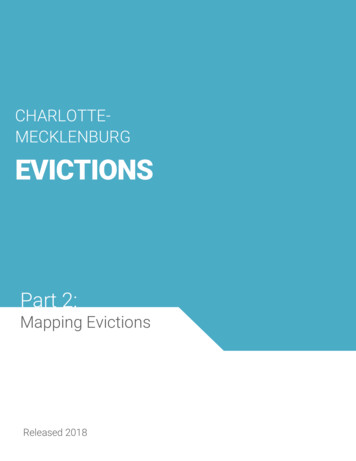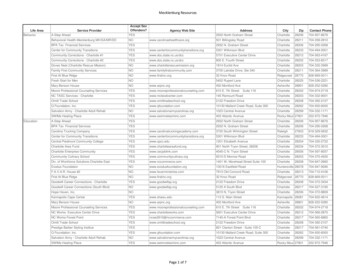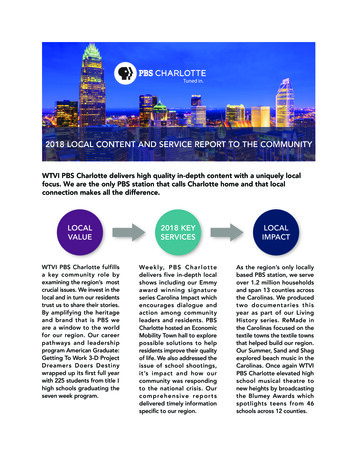
Transcription
CHARLOTTEMECKLENBURGEVICTIONSPart 2:Mapping EvictionsReleased20181 CONTENTS
PREPARED FORThe Housing Advisory Board ofCharlotte-MecklenburgFUNDING PROVIDED BYMecklenburg CountyCommunity Support ServicesPREPARED BYUniversity of North Carolina at CharlotteUrban InstituteThe Housing Advisory Board of Charlotte-Mecklenburg (HAB), formerly known as the Charlotte-Mecklenburg Coalition for Housing,is a volunteer appointed board charged with educating, advocating, engaging and partnering with community stakeholders to endand prevent homelessness and ensure a sufficient supply of affordable housing throughout the community. Members are appointedby the Mayor, City Council and the Mecklenburg Board of County Commissioners. HAB looks to national best practices and localresearch to make its recommendations to community stakeholders and providers, and advocates and advises on a strategic levelto reduce homelessness and increase affordable housing. In addition, HAB is responsible for the governance of the Continuum ofCare in Charlotte-Mecklenburg, which carries out activities as specified in 24 CFR part 578.5(b) of the Federal Register of the U.S.Department of Housing and Urban Development.The UNC Charlotte Urban Institute is a nonpartisan, applied research and community outreach center at UNC Charlotte. Founded in1969, it provides services including technical assistance and training in operations and data management; public opinion surveys;and research and analysis around economic, environmental, and social issues affecting the Charlotte region.
CONTENTS0411BACKGROUNDDATA & FINDINGS4. Authors & Reviewers11. Data5. Thanks13. Eviction Density6. About16. Eviction Rates andNeighborhood Clustering7. Key Definitions8. Introduction9. Key Findings23. Neighborhood Characteristics26. Conclusion10. Defining Evictions27REFERENCES & APPENDIX27. References28. Appendix3 CONTENTS
Authors &ReviewersAuthors& ReviewersAUTHORSAshley Williams Clark, MCRPKatie Zager, MAJustin Lane, MADirector of Outreach& Strategic PartnershipsUNC Charlotte Urban InstituteSocial Research SpecialistUNC Charlotte Urban InstituteData and Research SpecialistUNC Charlotte Urban InstituteWith Assistance fromLaura Simmons, MADirector of Community IndicatorsUNC Charlotte Urban InstituteREVIEWERSDustin Elliott, Mecklenburg County Sheriff’s OfficeTed Fillette, Legal Aid of North Carolina—CharlotteStacy Lowry, Mecklenburg County Community SupportServices, Housing Advisory BoardAndrey Melkonyan, Mecklenburg County Sheriff’s OfficeCarol Hardison, Crisis Assistance MinistryAmy Hawn Nelson, Actionable Intelligence for SocialPolicy, Housing Advisory BoardHelen Lipman, Mecklenburg County Community SupportServicesCourtney Morton, Mecklenburg County CommunitySupport ServicesKen Szymanski, Greater Charlotte ApartmentAssociationADDITIONAL INPUT PROVIDED BYCity of CharlotteCommunity LinkCrisis Assistance MinistryGreater Charlotte Apartment AssociationLegal Aid of North CarolinaSalvation Army of Greater Charlotte4 Authors & Reviewers
ThanksThanksFUNDING PROVIDED BYMecklenburg County Community Support ServicesMANY THANKS FOR THE ASSISTANCE OFMecklenburg County Sheriff’s OfficeThanks 5
AboutAboutThe 2017 Housing Instability & Homelessness Report Series is a collection of local reports designed to betterequip our community to make data-informed decisions around housing instability and homelessness.Utilizing local data and research, these reports are designed to provide informative and actionable researchto providers, funders, public officials and the media as well as the general population.The Housing Advisory Board of Charlotte-Mecklenburg outlined three key reporting areas that, together,comprise the 2017 series of reports for community stakeholders. The three areas include:1. POINT-IN-TIME COUNTAn annual snapshot of the population experiencing homelessness in Mecklenburg County. Thislocal report is similar to the national report on Point-in-Time Count numbers, and providesdescriptive information about both the sheltered and unsheltered population experiencinghomelessness on one night in January and the capacity of the system to shelter and house them.2. HOUSING INSTABILITYAn annual report focusing on the characteristics and impact of housing instability in the community.During the 2017 reporting cycle, this report will be divided up into several reports that focus onvarious aspects of evictions within Mecklenburg County.3. SPOTLIGHTAn annual focus on a trend or specific population within housing instability and homelessness.During the 2017 reporting cycle, this report will focus on the intersection of housing and schools.The 2017 reporting cycle is completed by the UNC Charlotte Urban Institute. Mecklenburg County CommunitySupport Services provides funding for the report series. The reports can be accessed athttp://MecklenburgHousingData.org6 About
Key DefinitionsDefinitionsKeyComplaint in summary ejectmentHomeownership rateA legal form that a landlord must complete in order toattempt to formally evict a tenant and regainpossession of the premises or unit. These tenants areat risk of formal eviction.The number of owner-occupied units as a percentageof all occupied housing units.Cost burdenedDescribes when a household spends more than 30%of their gross income on rent and utilities. If ahousehold spends more than 50% of their grossincome on rent and utilities, they are consideredextremely cost burdened.DefendantIn the case of complaints in summary ejectment, thedefendant is the person that the plaintiff is seeking toevict.Fair market rentAccording to 24 CFR 5.100, Fair Market Rent (FMR) isthe rent that would be required to be paid in aparticular housing market in order to obtain privatelyowned, decent, safe and sanitary rental housing ofmodest (non-luxury) nature with suitable amenities.The FMR includes utilities (except telephone). TheU.S. Department of Housing and Urban Developmentestablishes separate FMRs for dwelling units ofvarying sizes (number of bedrooms).Informal evictionA process of eviction that happens outside of thecourt system. It could consist of a landlord telling atenant they must move or a landlord paying a tenantto move.Judgment in summary ejectmentThe small claims court magistrate or district courtjudge completes this legal form with their judgment inthe summary ejectment case.PlaintiffIn the case of evictions, the plaintiff is typically thehousing provider (also referred to as the landlord) whoissues the complaint in summary ejectment.Rental leaseA written or oral contract between a landlord andtenant that grants the tenant the right to reside at apremises for a specified period of time and underspecific conditions, typically in exchange for anagreed upon periodic payment.Renter-occupiedFiscal yearA renter-occupied unit is a rental unit that is notvacant, but is occupied by a tenant.This report provides data based on the North CarolinaCourt System’s fiscal year, which is July 1 to June 30.TenureFormal evictionRefers to whether a unit is owner-occupied or renteroccupied.The legal process through which a landlord seeks toregain possession of a leased premises by concludinga tenant’s right to occupy the premises.Forced moveA move that is involuntary and may be due to a formaleviction, informal eviction, property foreclosure,property condemnation, or other reason that is notwithin the tenant’s choosing.Hold overWhen a tenant stays in the premises or unit after thelease terminates.VCAPThe online civil case processing system for the NorthCarolina Court System, which provides data onsummary ejectment case filings and results.Writ of possession for real propertyA form completed by a landlord to remove a tenantfrom a premises 10 days after a judgment has beengranted in favor of the landlord. The form issubmitted to the Clerk of Court who provides it to theMecklenburg County Sheriff’s Office to implement.The Sheriff’s Office will allow the landlord to padlockand secure the premises.Key Definitions 7
IntroductionEvictions play an important role at the intersection of housing stability, housing instability and homelessness.Every year in Mecklenburg County, there are over 20,000 households at risk of formal eviction through the court system.Inspired by Matthew Desmond’s book Evicted: Poverty and Profit in the American City and the need to better understandthe issue of evictions locally, the Housing Advisory Board of Charlotte-Mecklenburg chose to focus a series of reports onevictions in Mecklenburg County, North Carolina. Evictions in Charlotte-Mecklenburg Part 2: Mapping Evictions is thesecond report in this series.This is the first time eviction data have been mapped in Charlotte-Mecklenburg at the neighborhood level.While evictions take place throughout Mecklenburg County, they are concentrated in certain communities andneighborhoods. Part 2: Mapping Evictions maps two points in the eviction process: 1) the location of households whoreceive a complaint in summary ejectment, which means they are at risk of eviction and 2) where writs of possession toevict tenants were served. These two points in the formal eviction process are captured in data from the MecklenburgCounty Sheriff’s Office. While not all households at risk for formal eviction are ultimately evicted, it is an important indicatorof housing instability. When the writ is issued, it is an indicator that a household might not have the ability to move or findnew housing (the household has not filed an appeal or moved within 10 days of receiving the judgement from themagistrate that they are have been formally evicted). Cluster analysis is used to identify neighborhoods with highconcentrations of complaints in summary ejectment and writs of possession that were served. Neighborhood level datafrom the Quality of Life Explorer are incorporated to provide community context. While formal evictions are important tounderstand, they are an underrepresentation of all tenants who experience an eviction.Diagram 1. Overview of eviction report seriesCharlotte-Mecklenburg8 Introduction010203An Introductionto EvictionsMapping EvictionsOne-month Snapshot ofEviction Court RecordsPart 1 provides an overviewof the impact of evictions,the eviction process inMecklenburg County andcounty level data.Part 2 maps the locations ofhouseholds who received anotice of complaint insummary ejectment or a writof possession.Part 3 provides an in-depthlook into a one-monthsnapshot of eviction courtrecords from MecklenburgCounty.The report series can be accessed on the Charlotte-Mecklenburg Housing and Homelessness Dashboardhttp://MecklenburgHousingData.org
Key FindingsKey FindingsFrom FY2003 to FY2015, the number ofareas where evictions concentratedincreased and gradually shifted outwardtoward the edges of the county.The highest rates of households at risk offormal eviction and writs of possession arefound in North, East, and West Charlotte,extending to the edges of the county.The neighborhood indicators associated withhigher rates of households at risk of formaleviction were: Black/African-Americanpopulation, population under 18, public nutritionassistance, and neighborhood residentialrenovations. The indicators associated withlower rates of households at risk of formaleviction were development-based subsidizedhousing and single-family housing.The neighborhoods that have been andcontinue to be most affected by formalevictions are located in East, Northeast, West,and Southwest Charlotte.Neighborhoods with high rates of householdsat risk of formal eviction and writs ofpossession served tend to cluster near otherneighborhoods with high rates.In clusters of neighborhoods with high ratesof households at risk of formal eviction, theaverage rate of households at risk of formaleviction is more than double the county rateand the average rate of writs of possessionserved are almost three times the countyaverage.Households at risk of formal eviction in FY2015Density FY2015Rate FY2015Key Findings 9
Defining evictionsAn eviction is an action taken by a landlord to force a tenant with a writtenor oral lease to move from the premises where they reside. Evictions canbe both formal and informal. Formal evictions are a legal process throughwhich landlords1 attempt to regain possession of the premises from atenant. Informal evictions do not take place through the court system andrefer to landlord-initiated forced moves,i such as when a landlord tells thetenant they must leave or pays the tenant to move. Tenants may also beforced to move if the landlord defaults on their mortgage, increases rentssubstantially, or defers maintenance on the unit.ii One study estimates thatinformal evictions in Milwaukee2 comprised 48% of all forced moves(formal and informal).iii Other reasons for forced moves may include theproperty going into foreclosure, the property being condemned, or beingdemolished for redevelopment.ivLegal reasons a landlord can evict a tenantWith regard to formal evictions, there are four reasons3 listed on the NorthCarolina Complaint in Summary Ejectment form4 for why a landlord canattempt to evict a tenant with whom they have an oral or written lease:The defendant (tenant) failed to pay the rent due by a specific dateand the plaintiff (landlord) made demand for the rent and waited the10-day grace period before filing the complaint. In this case, thelandlord must prove all three conditions (prove failure to pay rent,prove that they made a demand for rent, and prove that the demandwas made 10 days before filing the complaint).The lease period ended on a specific date and the defendant isholding over after the end of the lease period. This reason isfrequently selected by landlords with week-to-week or month-tomonth-leases in situations where the tenant is remaining on thepremises after the lease expired. In this case, the landlord must provethat proper notice was given to the tenant that the lease ended.Landlords however, may include language in leases that significantlyreduce the time period required for notifying a tenant.EVICTIONWhen a tenant with awritten or oral lease isforced to move fromthe premises wherethey resideFormalLegal process in which alandlord seeks to regainpossession of a leasedpremises by concluding atenant’s right to occupythe premisesInformalTenant is forced to movefrom their premisesthrough methods otherthan the legal processThe defendant breached the condition of the lease for which re-entryis specified. This reason is most frequently selected by landlords with written leases in cases wherethere is nonpayment of rent or another reason that violates the lease.Criminal activity or other activity has occurred in violation of G.S. §42-63. This action can be taken ifthe tenant is current on rental payments but there has been criminal activity or another activity thatviolates G.S. 42-63. Under this provision, it is possible to evict a specific person or the entire household.The term “landlord” is sometimes referred to as the “provider” or “property owner.” For consistency, this report will use the term“landlord.”2 No data on informal evictions are available for Mecklenburg County. At the time of this study, Milwaukee was the only knownplace where informal evictions were studied in depth.3If a tenant is in federally subsidized housing, there may be additional procedural rights entitled to the tenant.4The “Complaint in Summary Ejectment” form is the legal document the landlord completes to attempt to evict the tenant.110 Defining evictions
DataThe Mecklenburg County Sheriff’s Office (Sheriff’s Office) is involved at two points in the formal evictionprocess, which are highlighted in blue in Diagram 3.Point 1. Tenant notified of complaint. The first point in the formal eviction process that involves theSherriff’s Office is when the tenant is notified that they are at risk of eviction (a complaint in summaryejectment is filed against them). When a landlord submits a complaint in summary ejectment toevict the tenant, the Sheriff’s Office initially serves the tenant with the complaint by first class mail,then makes a physical attempt to serve the complaint in person or by posting the property.Point 2. Writ of possession. The second point in the formal eviction process is when the court issuesa writ of possession. The Sheriff’s Office receives the writ of possession from the court and isresponsible for serving the writ. When a writ is served, the Sheriff’s Office oversees the landlordpadlock the unit and remove the tenant. The writ of possession data are important because theyreflect tenants who did not move out on their own during the 10 day waiting period or file an appeal.These families may not have moved because they lacked the means to do so or were unable to findanother affordable and decent unit. Not all writs of possession are executed. The writ may bereturned at the request of the plaintiff because the tenant paid rent, they came to an agreement, thetenant moved, or the tenant received social services support to stay in their home. For this report,writs of possession were limited to only those that were successfully served by the Sheriff’s Office.Any writs that were returned or had an invalid address were not included.5The Sheriff’s Office provided address-level data for all notices of complaint in summary ejectment and writsof possession from FY2002 to FY2015. Addresses from these data were cleaned, geocoded and mappedusing the ESRI ArcMap 10.4 Geographic Information System. The data includes both single-family and multifamily units. Due to the data format, single-family and multi-family units could not be distinguished from oneanother. Future analyses could include linking these data to parcel-level data to examine summary ejectmentsand writs of possession at individual properties.It is important to note that the Sheriff’s Office does not make any decisions regarding eviction cases; it isresponsible only for administering what is required by the court.Diagram 2. Overview of data analysis processObtain dataCleanMapAnalyzeCoordinated withthe Sheriff’sOffice to obtaindata related toevictionsResearch teamcleaned data andlimited the writs ofpossession to onlythose that wereservedAddress datawere geocodedand mappedusing GISLinked withQuality of LifeExplorer data toanalyze dataacrossneighborhoods5 FromFY2003 to FY2015 the Sheriff’s Office served 60% of all writs received. The remaining writs were not served due to reasonssuch as the writ being returned at the request of the plaintiff or Clerk’s office and incorrect or incomplete addresses.Data 11
Diagram 3. Eviction Process in Mecklenburg CountyColored circles reflect steps in eviction process that involve the Sheriff’s Office!Lease agreementOral or writtenagreementIssueRent not paid or otherlease violation such astenant breaks law ordoes not leave afterlease endsTenant is forced to moveTenant told they must leave, tenantpaid to move, property goes intoforeclosure, property is sold, orproperty is not maintained.This is a forced move.1 Tenant served with a summonsLandlord filescomplaint in summaryejectment formTenant is notified of complaintand served with magistratesummons to appear for hearingTenant leaves toavoid formal evictionThis is an informalevictionLandlord and tenantcome to anagreementEviction avoided(dismissal)Landlord proves caseJudgment for landlord tobe put in possession ofpremisesLandlord and tenantcome to anagreementEviction avoidedTenant orrepresentative appearsand proves caseEviction avoidedSmall claims court hearingBoth sides have opportunity to arguetheir case. Many tenants do notappear in court and do not have legalrepresentation. Most landlords havelegal representation.Tenant moves outwithin 10 daysEvictedTenant does notappeal or movewithin 10 daysTenant files anappeal within 10daysIf tenant appealsthey must pay thecourt fee in advanceas well as their rentEviction temporarilyavoided12 DataWrit of possessionLandlord files a writ ofpossession to removetenant from premisesTenantmovesEvicted2 Sheriff executes writLandlord andtenant cometo anagreementEvictionavoidedand tenant is requiredto leaveSheriff receives writ ofpossession and notifiestenant of when they planto padlock the property.Sheriff goes withlandlord to padlock thepremises. The tenant isrequired to leave.EvictedTenant retrievespersonal propertyTenant has 5 to 7days to retrievepersonal property.Tenant may not beable to pay to havelarge itemsremoved or afford astorage unit.
FindingsThe findings from the eviction data analysis are organized in the following sections:1.Eviction density. Where in Mecklenburg County are the largest concentrations of complaints insummary ejectment and writs of possession served and how has this changed over time?2.Eviction rates and clustering. Which neighborhoods have the highest rates of complaints insummary ejectment and writs of possession served when we account for underlying housingdensity? Are these neighborhoods clustered?3.Neighborhood characteristics. What are the characteristics of the neighborhoods with highor low rates of complaints in summary ejectment or writs of possession served?4.Eviction DensityFrom FY2003 to FY2015, the number of areas where evictions concentrated increased and gradually shiftedoutward toward the edges of the county.The neighborhoods that have historically and continue to be most affected by formal evictions are located inEast, Northeast, West, and Southwest Charlotte.The following series of maps show how the density of complaints in summary ejectment notifications andwrits of possession served varies across the county and how these patterns have changed over time.6 Thesemaps pinpoint where, regardless of neighborhood boundaries, a large number of evictions have taken place.Darker areas indicate places where there were more complaints in summary ejectment or writs of possession.Maps from three points in time are included in Figure 1 and Figure 2: FY2003 (before the Great Recession),FY2009 (during the Great Recession), and FY2015 (after the end of the Great Recession).7 From FY2003 toFY2015 the number of complaints in summary ejectment decreased. This decrease in case filings couldpossibly coincide with changes in the number of informal evictions or changes in tenant screening practices,but it is not possible to know for sure.While the total volume of complaints in summary ejectment and writs of possession served varied over time,the maps reveal largely similar patterns. In FY2003, one area in East Charlotte (near the intersection of W.T.Harris Boulevard and Albemarle Road) stands out as having the highest density of both complaints insummary ejectments and writs of possession served. Other areas with relatively high densities were locatedprimarily in other parts of East, West, and to a lesser extent, Southwest and Northeast Charlotte.In FY2009, the Eastside cluster still had the highest density of evictions, but it was not as pronounced asbefore. At the same time, the concentration of evictions became more pronounced in some of the other areasthat already had relatively high density of complaints in summary ejectments and especially writs ofpossession served, such as Northeast and Southwest Charlotte.In 2015, the number and extent of areas with high concentrations of evictions continued to grow and expandfurther out into the Northeast and Southeast edges of the county. To some degree, this outward shift inevictions reflects the continued suburbanization and expansion of overall development in the periphery of thecounty as well as the suburbanization of poverty. At the same time, many areas appeared to have high orrelatively high concentrations of evictions across all three time periods, indicating that evictions are anenduring problem in these neighborhoods.6 Addresseswere first mapped as dots, then smoothed into 2 mile diameter ‘neighborhoods’ to help display the underlying density ofevictions.7For maps from additional years, please refer to the Appendix.Findings 13
Figure 1: Density of Complaint in Summary Ejectment notifications FY2003 to FY2015Note: The scale of each density map is based on the total number of complaints in summary ejectment for that year. If anarea gets darker over time, it does not necessarily mean that the total number of complaints in that area increased. Rather,it indicates that the number of complaints in that area increased relative to other areas of the county that year.FY2003FY2009FY2015N 39,014N 38,613DensityN 31,71914 Findings
Figure 2: Density of Writs of Possession served, FY2003 to FY2015Note: The scale of each density map is based on the total number of writs for that year. If an area gets darker over time,it does not necessarily mean that the total number of writs in that area increased. Rather, it indicates that the number ofwrits in that area increased relative to other areas of the county that year.FY2003FY2009FY2015N 5,672N 7,392DensityN 6,694Findings 15
Eviction rates and neighborhood clusteringThe highest rates of complaints in summary ejectment and writs of possession per 100 renter units arefound in North, East, and West Charlotte, extending to the edges of the county.Neighborhoods with high rates of complaints in summary ejectment and writs of possession served tend tocluster near other neighborhoods with high rates.In clusters of neighborhoods with high rates of complaints in summary ejectment, the average rate ofcomplaints in summary ejectment is more than double the county rate and the average rate of writs ofpossession are almost three times the county average.RatesMapping eviction density helps to show where concentrations of complaints in summary ejectment and writsof possession are taking place. However, each neighborhood has a different amount of rental units, whichcan in turn impact the number of evictions. We account for the underlying density of rental units by alsomapping the rate of complaints in summary ejectments and writs of possession served per 100 renterhouseholds.8 Mapping this rate enables the examination of which neighborhoods might have especially higheviction rates, regardless of the underlying rental supply.9 Figure 3 shows the rate of complaints in summaryejectment and writs of possession that were served per 100 renter households in FY2015. While rates varyamong neighborhoods, both maps show a similar pattern. Higher rates are found in North, East, and WestCharlotte, extending to the edge of the county. These areas with higher rates have a larger share of renterhouseholds and are more racially and economically diverse than the areas with the lowest rates. The lowestrates are in the South Charlotte ‘wedge’ that extends south from Uptown to Ballantyne and is bordered byIndependence Boulevard and South Boulevard, and in the suburbs in North and Southeast Mecklenburg.10When examined together in Chart 1, it appears that neighborhoods with more complaints in summaryejectment tend to have more writs of possession served (there is a positive correlation). However, there isvariation as the rate of complaints in summary ejectment increases and more outliers begin to emerge. Thereare a few neighborhoods with similar rates of summary ejectment but fairly different rates of writs ofpossession (for example neighborhoods 83 and 290, and neighborhoods 183 and 316). These areas warrantfurther investigation as to why there are differences in the rates of writs of possession served, yet similar ratesof complaints in summary ejectment.Neighborhood clustersIn addition to visualizing the patterns of eviction rates on the map, we ran a statistical test (Global Moran’s i)to confirm whether neighborhoods with high or low rates of complaints in summary ejectment and writs ofpossession were in fact as clustered as they appear. This analysis revealed that the patterns on the maps arenot random and that neighborhoods with high rates of summary ejectments and writs of possession areindeed clustered near other neighborhoods with high rates.11Further, we used a related statistical test to identify several types of neighborhood clusters. If the summaryejectment or writ of possession rate in the neighborhood was significantly lower than the rates around it, theneighborhood is considered a Low-High Outlier. Similarly, a neighborhood with a higher value than its8 Thenumber of evictions per Neighborhood Profile Area (NPA or neighborhood) was divided by the number of renter households toget a neighborhood rate of summary ejectments and writ of possessions. NPA’s with fewer than 20 renter households were excludeddue to excess variation in rates. The number of renter households was calculated using data from the Quality of Life Explorer and2015 American Community Survey 5-year estimates. For more information on NPAs and the Quality of Life Explorer seehttp://mcmap.org/qol. For a neighborhood reference map, see the Appendix.9 Ratesof summary ejectment range from zero to 150% (which can happen when households are served more than once in a FiscalYear), while rates of Writs of Possession range from 0 to 60%. Darker areas indicate higher rates.10 For demographic information on these areas, please refer to mcmap.org/qol. Demographic information for clusters ofneighborhoods with high rates of summary ejectments and writs of possession are detailed in Table 1 and Table 2.11 A local Moran’s i test was used to evaluate the statistical significance of each neighborhood rate in relation to the 8 closestneighborhoods around it.16 Findings
neighbors is a High-Low outlier. If a neighborhood and its neighbors are all significantly higher or lower thanthe surrounding neighborhoods, they are part of a high-high or low-low cluster respectively. The high-highclusters indicate which neighborhoods have especially high rates of summary ejectments and writs ofpossession. As the chart shows, there were very few high-low or low-high areas, but multiple, l
Care in Charlotte-Mecklenburg, which carries out activities as specified in 24 CFR part 578.5(b) of the Federal Register of the U.S. Department of Housing and Urban Development. The UNC Charlotte Urban Institute is a nonpartisan, applied research and community outreach center at UNC Charlotte.








![Mecklenburg College Annual Catalogue [1963-1964]](/img/32/mecklenburgcolle159carv.jpg)

